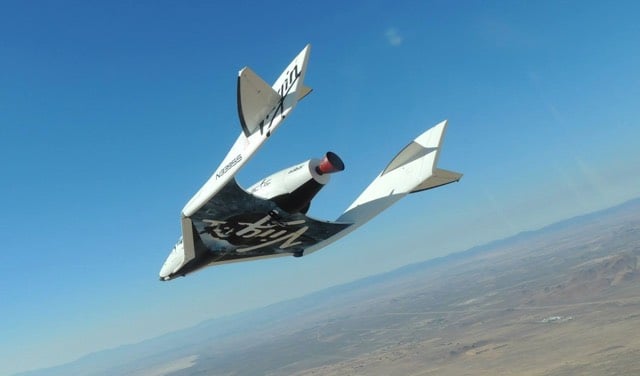
From Vanity Fair’s William Langewiesche, who has written extensively on the aviation industry and is a pilot himself, a detailed account of what happens during a space flight on Richard Branson’s Virgin Galactic.
Accelerating through Mach 0.95, the aircraft wobbles as shock waves develop on its wings and tails. This is known as a burble, and it marks the entry into supersonic flight. The shock waves change the airflow over the conventional control surfaces — the elevons — and render them almost useless, forcing the pilot in supersonic flight to fly entirely by trimming the stabilizers on the tail. Flying by trim is difficult to do well, but with pilots like these the passengers probably don’t need to worry. At Mach 1, the pilot rolls the pitch trim aft to a pre-determined position, and the spaceship responds by bending the flight path upward at a rate that pushes the passengers straight down into their seats with a force of 2.5 Gs. The passengers are now experiencing a total of 5.5 Gs, divided between two distinct vectors, and are rotated onto their backs as the spaceship accelerates ever more steeply upward. As they approach the vertical, nearing Mach 2, the pilot rolls the trim forward to capture the position, and 2.5 Gs are stripped away. Pointing straight up, the ship rockets into air growing so thin that the aerodynamic speeds decrease rapidly even as the ship keeps accelerating through Mach 3. At around that time, after about one minute of burn, and when an onboard instrument shows that the vehicle has sufficient energy to follow a ballistic path into space, the pilots shut down the rocket motor. The effect for the passengers, who are lying on their backs, facing straight up, is to go immediately from a condition of three Gs to the zero-G state called weightlessness.
Vanity Fair’s William Langewiesche takes a behind the scenes look at what drove Felix Baumgartner from being a stunt jumper to stepping out of a capsule 24 miles above New Mexico. Grab a few Red Bulls and read all about the man who pierced the sky (and the world of brand advertising).
His goal now was to break the altitude record for a human free fall, and in the process also to exceed the speed of sound. Otherwise known as Mach 1, that speed varies with temperature but is upwards of 660 miles per hour. Baumgartner was not there to advance mankind. That was for others to claim, if they liked. His own purpose was promotional. He was a showman for the Red Bull company, which had plowed a fortune into this endeavor in order to associate its energy drink with his feats. Baumgartner, who was 43 at the time, is certainly a manly man. He is photogenic. He is fit. His fiancée was Miss Lower Austria in 2006. When he furrows his brow he looks determined and intense. On-camera he becomes the very image of a middle-aged action figure, the perfect emblem for an important market segment of middle-aged men. When I drink Red Bull, I go supersonic. I am fearless. I am an Übermensch.
From the Feb 2011 issue of Vanity Fair, a profile of big-wave surfer Ken Bradshaw by William Langewiesche. Bradshaw rode what was, at the time, the largest wave ever surfed.
Later he told me it was like skiing down an avalanche chute in the mountains. He said, “You know that feeling you get when you’re going over a cornice and it’s just straight down after that?” He counted the seconds. He went, “One. Two. Three. Four!” Already it was a long drop, and the wave kept rising higher. “Five! Six! Seven! Eight!” He went, “Holy shit!,” and kept dropping. He went, “Don’t fade! Don’t even imagine it!” He got toward the base of the face, still well above the bottom, and rounded out of the drop as the surface curvature allowed. Bradshaw had never seen such wave expanses before-huge fields of sloping water to the right. He was aware of the mass gathering above and behind him. He went, “I gotta get out of here, now!” He dug his right rail in, banking the board hard against its will, and held it with all of his strength into a carving right turn. The turn was slow because the board was fast. Bradshaw kept at it, however, and went slicing up the wave face almost to the crest. He was briefly elated. Technically he had “made” the wave, but he wasn’t done with it yet. From the crest he turned again and went angling back down the face. He intended to perform a full cutback toward the break, but no sooner had he started than a roar erupted behind him as the wave formed a giant barrel. The barrel spat spray at him from its throat. There was no way into that barrel from his position, and it blocked any turn back toward the core of the wave. The ride was almost over for Bradshaw. It had lasted 30 seconds, or hardly more. He exited straight ahead and over the wave’s shoulder. He was angry with himself. He thought that he should have been in that barrel, and that he would have been if he had not shied away from the peak at the start of the ride. He did not care about having made history-and did not consider it until others began to insist on it that night. He did not even think that this had been a great run. He thought, Shit, I should have faded.






Stay Connected